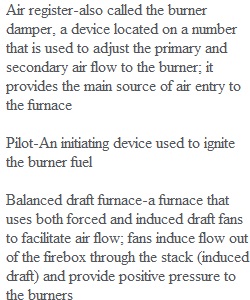


Q Process Technology Equipment Ch. 13 Test a. Refractory lining b. Air register c. Pilot d. Balanced draft furnace e. Convection section f. Assisted draft furnace g. Bumpers h. Cabin furnace i. Damper j. Firebox k. Coke l. Fuel lines m. Box furnace n. Furnace o. Convection tubes p. Heater q. Nitrogen oxides (NOx) r. Radiant section s. Induced draft furnace t. Stack u. Radiant tubes v. Natural draft furnace w. Radiation x. Shock bank (shock tubes) y. Stack damper z. Vertical cylindrical furnace A . Force draft furnace 1.__-also called the burner damper, a device located on a number that is used to adjust the primary and secondary air flow to the burner; it provides the main source of air entry to the furnace. 2.__a system that uses electric motors, steam turbine-driven rotary fans, or blowers to push air into the furnace (forced draft) or to draw flue gas from the furnace to the stack (induced draft). 3.__a furnace that uses both forced and induced draft fans to facilitate air flow; fans induce flow out of the firebox through the stack (induced draft) and provide positive pressure to the burners (forced draft). 4.__ a square, box-shaped furnace designed to heat process fluids or to generate steam. 5.__-devices with open flames used to provide heat to the firebox; the number of burners needed depends on the furnace's size and capacity. 6.__a cabin-shaped furnace designed to heat process fluids or to generate steam. 7.__-Carbon deposits inside process tubes (coking), which can result in poor heat transfer to process fluid and in overheating and failure of the tube metal. 8.__-the upper and cooler section of a furnace where heat is transferred and convection tubes absorb heat, primarily through the method of convection; the part of the furnace where process feed and/or steam enters. 9.__-furnace tubes, located above the shock bank tubes, that receive heat through convection. 10.__-a device that regulates the flow of air into a furnace and flue gases leaving a furnace. 11.__the combustion area and hottest section of the furnace where burners are located and radiant heat transfer occurs. 12.__a furnace that uses fans or blowers to force the air required for combustion into the burner's air registers. 13.___Supply lines that provide the fuel to operate the burnes 14.__-a piece of equipment in which heat is released by burning fuel and is transferred directly or indirectly to a fluid mass for the purpose of increasing the temperature of fluids flowing through tubes to effect a physical or chemical change; also referred to as a process heater. 15.__a term used to describe a fired furnace. 16.__a furnace that uses fans, located between the convection section and the stack, to pull air up through the furnace and induce air flow by creating a lower pressure in the firebox. 17.__-a furnace that has no fans or mechanical means of producing draft; instead, the heat in the furnace causes natural draft. 18.__undesirable air pollution produced from reactions of nitrogen and oxygen. The primary NO, species in process heaters are nitric oxide (NO) and nitrogen dioxide (NO>). 19.__-An initiating device used to ignite the burner fuel. 20.__-the lower portion of a furnace where heat transfer is primarily through radiation. 21.__ tubes located in the firebox that receive heat primarily through radiant heat transfer. 22.__-the transfer of heat by electromagnetic waves. 23.__a form of insulation used inside high temperature boilers, incinerators, heaters, reactors, and furnaces; a common type is called fire brick. 24.__-also called the shield section, a row of tubes located directly above the firebox (radiant section) in a furnace that receives both radiant and convective heat; protects the convection section from exposure to the radiant heat of the firebox. 25.__--a cylindrical outlet, located at the top of a furnace, through which flue (combustion) gas is removed from the furnace. 26.__-a device that regulates the flow of flue gases leaving a furnace. 27.__ a furnace design in which the radiant section tubes are laid out in a vertical configuration along the walls of the cylinder; it has a smaller footprint than a cabin furnace and is used in operations where less heat capacity is required. Knowledge 28. Furnaces are used to: a.increase the temperature of a fluid b. release gases to the environment c. decrease temperature and pressure d. increase the viscosity of a fluid 29. Which of the following is NOT a common type of furnace? a. Cabin b. Spherical C. Box d. Vertical cylindrical 30. Select the components that are associated with a furnace. (Select all that apply) a. Radiant tubes b. Bridgewall C. Fuel valve d. Tube sheet 31. List three possible consequences for a furnace when there is insufficient air and the furnace becomes too fuel-rich. 32. (True or False) Industrial furnaces are operated at posi- tive pressure. 33. Periodic cleaning is required on the a. stack b. burner fuel lines c. bridgewall d. shock bank 34. Which of the following hazards can cause cooling of the furnace? (Select all that apply.) a. Poor control of excess air and draft b. Bypassing safety interlocks c. Opening furnace inspection ports when the firebox pressure is greater than the atmospheric pressure d. Increasing the air into the furnace 35. (True or False) CO is an asphyxiant that can cause death in high enough concentrations. 36. Which of the following is NOT a potential problem in furnace operation? a. Quick startup b. Plugging of the process tubes C. Positive pressure in the firebox d. Uniform flame height and uniform process flame color 37. (True or False) When using combination burners, firebox temperature must be near the operating range before fuel oil is introduced. 38. What is required for the decoking procedure? (Select all that apply.) a. Air b. Water c. Steam d. Bleach 39. (True or False) A process technician completes the in- spection of the furnace's internal components. PreviousNext
View Related Questions